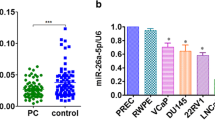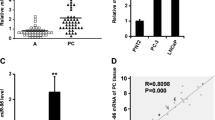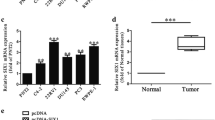Abstract
Prostate cancer is the second leading cause of cancer-related deaths of men. Bmi-1, a member of PcG family of proteins, has been implicated in the pathogenesis of prostate cancer, and disturbed profile of microRNAs (miRNAs) has been found in prostate cancer tissues. How Bmi-1 is regulated by miRNAs is unclear. In this study, we screened 18 miRNAs that potentially repress the expression of Bmi-1 using a dual luciferase system and found that 12 miRNAs could bind with the 3′-untranslated region of Bmi-1 mRNA. Using qRT-PCR, we found that expression of miR-221, -15a, and -30d was significantly reduced in prostate cancer tissues. Subsequent functional study indicated that miR-221 and miR-30d can repress prostate cancer cell proliferation, and this effect can be partially rescued by Bmi-1 overexpression. Our study constructs the relation between downregulated miR-221 and miR-30d and prostate cancer pathogenesis. These results indicate that miR-221 and miR-30d are candidate tumor suppressor miRNAs in prostate cancer and therefore serve as potential clinical classification markers and therapeutic targets for human prostate cancer.
Similar content being viewed by others
Abbreviations
- AGO2:
-
Argonaute RISC catalytic component 2
- Bmi-1:
-
B-cell specific Moloney leukemia virus insertion region homolog 1 (oncoprotein from PcG (polycomb group))
- GAPDH:
-
glyceraldehyde-3-phosphate dehydrogenase
- miRNA:
-
microRNA
- PCa:
-
prostate cancer
- siRNA:
-
small interfering RNA
- 3′-UTR:
-
3′-untranslated region
References
Siddique, H. R., and Saleem, M. (2012) Role of BMI1, a stem cell factor, in cancer recurrence and chemoresistance: preclinical and clinical evidences, Stem Cells, 30, 372–378.
Kang, M. K., Kim, R. H., Kim, S. J., Yip, F. K., Shin, K. H., Dimri, G. P., Christensen, R., Han, T., and Park, N. H. (2007) Elevated Bmi-1 expression is associated with dysplastic cell transformation during oral carcinogenesis and is required for cancer cell replication and survival, Brit. J. Cancer, 96, 126–133.
Atala, A. (2013) Re: Akt-mediated phosphorylation of Bmi1 modulates its oncogenic potential, e3 ligase activity, and DNA damage repair activity in mouse prostate cancer, J. Urol., 189, 771.
Ammirante, M., Kuraishy, A. I., Shalapour, S., Strasner, A., Ramirez-Sanchez, C., Zhang, W., Shabaik, A., and Karin, M. (2013) An IKKalpha-E2F1-BMI1 cascade activated by infiltrating B cells controls prostate regeneration and tumor recurrence, Genes Devel., 27, 1435–1440.
Lukacs, R. U., Memarzadeh, S., Wu, H., and Witte, O. N. (2010) Bmi-1 is a crucial regulator of prostate stem cell self-renewal and malignant transformation, Cell Stem Cell, 7, 682–693.
Wu, W. K., Lee, C. W., Cho, C. H., Fan, D., Wu, K., Yu, J., and Sung, J. J. (2010) MicroRNA dysregulation in gastric cancer: a new player enters the game, Oncogene, 29, 5761–5771.
Nicoloso, M. S., Spizzo, R., Shimizu, M., Rossi, S., and Calin, G. A. (2009) MicroRNAs — the micro-steering wheel of tumor metastases, Nature Rev. Cancer, 9, 293–302.
Srivastava, A., Goldberger, H., Dimtchev, A., Marian, C., Soldin, O., Li, X., Collins, S. P., Suy, S., and Kumar, D. (2014) Circulatory miR-628-5p is downregulated in prostate cancer patients, Tumor Biol. J. Int. Soc. Oncodevel. Biol. Med., 35, 4867–4873.
Qiang, X. F., Zhang, Z. W., Liu, Q., Sun, N., Pan, L. L., Shen, J., Li, T., Yun, C., Li, H., and Shi, L. H. (2014) miR-20a promotes prostate cancer invasion and migration through targeting ABL2, J. Cell. Biochem., 115, 1269–1276.
Ottman, R., Nguyen, C., Lorch, R., and Chakrabarti, R. (2014) MicroRNA expressions associated with progression of prostate cancer cells to anti-androgen therapy resistance, Mol. Cancer, 13, 1.
Bhattacharya, R., Nicoloso, M., Arvizo, R., Wang, E., Cortez, A., Rossi, S., Calin, G. A., and Mukherjee, P. (2009) MiR-15a and MiR-16 control Bmi-1 expression in ovarian cancer, Cancer Res., 69, 9090–9095.
Guo, S., Xu, X., Tang, Y., Zhang, C., Li, J., Ouyang, Y., Ju, J., Bie, P., and Wang, H. (2014) miR-15a inhibits cell proliferation and epithelial to mesenchymal transition in pancreatic ductal adenocarcinoma by down-regulating Bmi-1 expression, Cancer Lett., 344, 40–46.
Hoffmann, M. J., Engers, R., Florl, A. R., Otte, A. P., Muller, M., and Schulz, W. A. (2007) Expression changes in EZH2, but not in BMI-1, SIRT1, DNMT1 or DNMT3B are associated with DNA methylation changes in prostate cancer, Cancer Biol. Ther., 6, 1403–1412.
Author information
Authors and Affiliations
Corresponding author
Additional information
Published in Russian in Biokhimiya, 2015, Vol. 80, No. 3, pp. 339–347.
Originally published in Biochemistry (Moscow) On-Line Papers in Press, as Manuscript BM14-144, January 25, 2015.
Rights and permissions
About this article
Cite this article
Xuan, H., Xue, W., Pan, J. et al. Downregulation of miR-221, -30d, and -15a contributes to pathogenesis of prostate cancer by targeting Bmi-1. Biochemistry Moscow 80, 276–283 (2015). https://doi.org/10.1134/S0006297915030037
Received:
Revised:
Published:
Issue Date:
DOI: https://doi.org/10.1134/S0006297915030037




